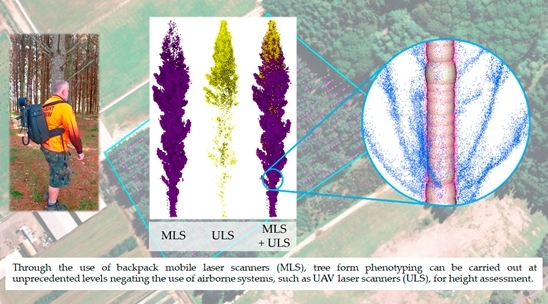Revolutionary mobile laser scanning new technology tested
In a recently published research article, a team of scientists from Scion tested a new type of mobile laser scanner (MLS) technology in a stand of mature radiata pine trees. The study evaluated the performance of the system for assessing tree form attributes including the diameter at breast height (DBH), stem volume, height, and branching (whorl location). The aim of the study was to see whether this system could be useful for digital tree phenotyping – an emerging science that uses equipment like laser scanners to compare tree form with environmental, genetic and forest management variables to identify the right trees to grow in the right place and for the right purpose.
According to lead author, Mr. Hartley, “‘Phenotyping allows us to assess the form of hundreds of trees in a very short space of time. An operation that used to take weeks can now be done in a matter of days or even hours. Not much work has been conducted previously on applying MLS technology to mature plantation species, particularly to Pinus radiata, so it’s exciting to be exploring this area.”
The Hovermap system is particularly suited to a forest environment as it has an array of lasers which spin 360 degrees on one axis, and then revolve 360 on a perpendicular axis, creating full spherical coverage. When mounted to a backpack and carried underneath the forest, this system gets extremely good coverage of the tree stems, branches and up into the canopy.
One of the drawbacks with traditional ground-based LiDAR systems, also referred to as terrestrial laser scanners (TLS), is that they often cannot scan to the top of the forest canopy, meaning that tree heights need to be captured by a separate airborne capture, for example from a UAV. A key finding of this study was that data acquired from the MLS data was capable of measuring the forest canopy with an accuracy that is comparable to the data from a high-end UAV laser scanner (ULS), removing the need for above-canopy data captures.

The study also compared different methods for deriving diameter at breast height (DBH) from the trees to assess the most effective methods. ”This paper lays out a thorough methodology for data capture and a processing pipeline making it possible for others to follow“, added Mr. Hartley.
So, what does this mean for forestry? This means that tree breeders and foresters will have a more efficient tool for assessing and comparing how different genotypes grow in different growing conditions. It could also be very useful for conducting inventory of small woodlots for lower costs in less time, and possibly with higher accuracy.
‘There is still more work to be done, and we need to test this method in different environments, more rugged terrain, more blackberry etc, however, it is a solid start and should hopefully be of use to those who are currently looking at applying this technology to their forest measurement procedures.’ – Lead Author, Robin Hartley, Autonomous Systems Scientist (Scion) and TFF Committee Member.
This research was funded by Scion’s Strategic Science Investment Funding (SSIF) provided by the Ministry of Business Innovation and Employment (MBIE). Additional co-funding was provided by the Forest Growers Levy Trust and the MBIE Transforming Tree Phenotyping programme.
Full article is freely available here: https://doi.org/10.3390/rs14143344
